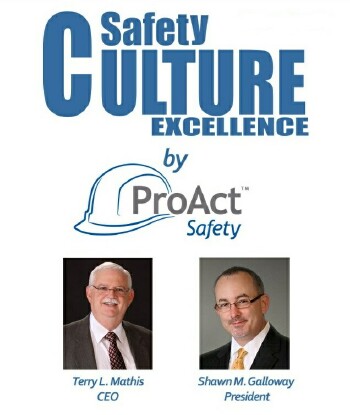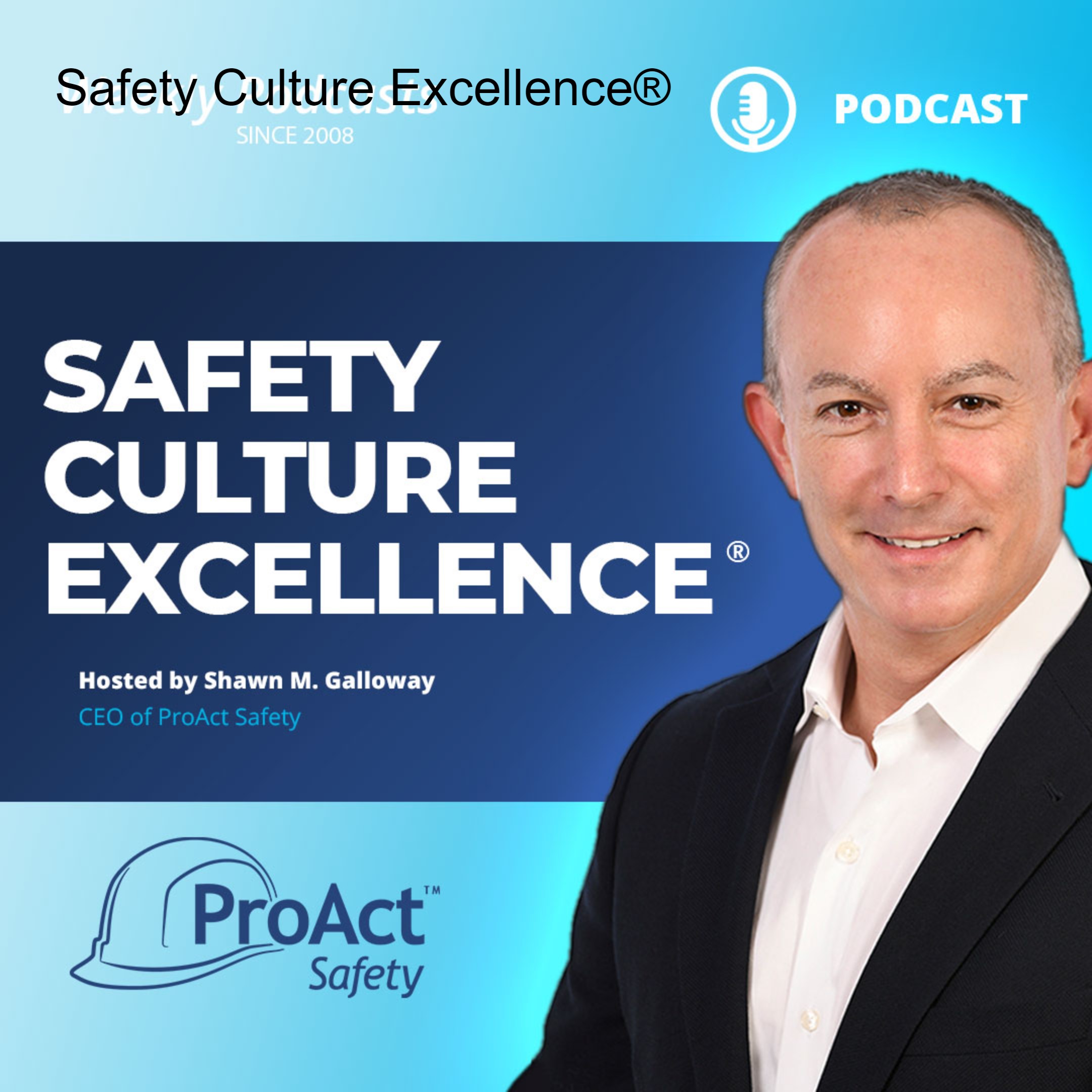Episodes

Monday Jan 26, 2015
372 - Client and Contractor: Aligning Safety Cultures
Monday Jan 26, 2015
Monday Jan 26, 2015
Greetings everyone, this podcast recorded while in Coldspring, TX. I’d like to share an article I wrote that was published in OH&S Magazine. The published article can either be found on the magazine’s website or under Insights at www.ProActSafety.com.
I hope you enjoy the podcast this week. If you would like access to archived podcasts (older than 90 days – dating back to January 2008) please visit www.ProActSafety.com/Store. For more detailed strategies to achieve and sustain excellence in performance and culture, pick up a copy of our book, STEPS to Safety Culture Excellence - http://proactsafety.com/insights/steps-to-safety-culture-excellence
Have a great week!
Shawn M. Galloway
ProAct Safety


Wednesday Jan 14, 2015
Much Ado About Zero
Wednesday Jan 14, 2015
Wednesday Jan 14, 2015
The furor about “zero accidents” would have inspired Shakespeare to write a play. It is, indeed, a tempest in a teapot, full of sound and fury, signifying nothing. Of course, every organization should desire to be accident free and, of course, they should not set goals that develop a tolerance for a certain level of accidents. On the other hand, goals of perfection can be demotivating when they are consistently not reached, and preaching “zero accidents” while practicing “hurry and get it done” will usually backfire.
The bottom line is, whatever you set as a goal, if you don’t have a systematic strategy for reaching success, and if your strategy is impractical, misunderstood, or not believed to be real, your goal is meaningless. Zero accidents is not a direct product you can manufacture; it is the by-product of excellent strategy and excellent execution. Setting goals for the process and monitoring the value derived from the efforts, rather than simply measuring lagging indicators, is a clearer and cleaner path to success.
-Terry L. Mathis
For more insights, visit www.ProActSafety.com
Terry L. Mathis is the founder and CEO of ProAct Safety, an international safety and performance excellence firm. He is known for his dynamic presentations in the fields of behavioral and cultural safety, leadership, and operational performance, and is a regular speaker at ASSE, NSC, and numerous company and industry conferences. EHS Today listed Terry as a Safety Guru in ‘The 50 People Who Most Influenced EHS in 2010, 2011 and 2012-2013. He has been a frequent contributor to industry magazines for over 15 years and is the coauthor of STEPS to Safety Culture Excellence, 2013, WILEY.


Monday Jan 12, 2015
370 - Becoming a Rising Star in Safety
Monday Jan 12, 2015
Monday Jan 12, 2015
Greetings everyone, this podcast recorded while in Minneapolis, MN. I’d like to share an article I wrote that was published in OH&S Magazine. The published article can either be found on the magazine’s website or under Insights at www.ProActSafety.com.
I hope you enjoy the podcast this week. If you would like access to archived podcasts (older than 90 days – dating back to January 2008) please visit www.ProActSafety.com/Store. For more detailed strategies to achieve and sustain excellence in performance and culture, pick up a copy of our book, STEPS to Safety Culture Excellence - http://proactsafety.com/insights/steps-to-safety-culture-excellence
Have a great week!
Shawn M. Galloway
ProAct Safety


Wednesday Jan 07, 2015
Root Cause Analysis is Machine Thinking
Wednesday Jan 07, 2015
Wednesday Jan 07, 2015
Seeking out and addressing root causes of problems is the ultimate fix for machines. If you simply repair the obvious failure, it may recur. People are not machines! Using root cause thinking with humans can actually make you miss the best solutions, especially in safety. It is extremely limited thinking to look exclusively at human contribution as the problem or failure in accidental injuries.
Human behavior is based on a complex mixture of influences and projections. Past experience, training, analyses of job hazards, projections of what could cause injuries, and the overriding pressures to complete the work all influence behavioral choices. A change in the weight of any of these or other influences can tip the balance of influence and change the logic of the choice. Failure to identify risks due to low-probability or other factors play into the equation. Simply underestimating risk probability is a growing problem. Distractions to concentration at work are also growing as work gets more complex and technology increases the availability and amount of communication.
Rather than viewing human performance as a mechanical process, we need to see it more like a weather pattern that can be changed by multiple factors, something that needs to be forecast rather than fixed.
-Terry L. Mathis
For more insights, visit www.ProActSafety.com
Terry L. Mathis is the founder and CEO of ProAct Safety, an international safety and performance excellence firm. He is known for his dynamic presentations in the fields of behavioral and cultural safety, leadership, and operational performance, and is a regular speaker at ASSE, NSC, and numerous company and industry conferences. EHS Today listed Terry as a Safety Guru in ‘The 50 People Who Most Influenced EHS in 2010, 2011 and 2012-2013. He has been a frequent contributor to industry magazines for over 15 years and is the coauthor of STEPS to Safety Culture Excellence, 2013, WILEY.

Monday Dec 29, 2014
368 - Measure What You Want
Monday Dec 29, 2014
Monday Dec 29, 2014
Greetings all, here is a short video for this week's podcast. I hope it gets you thinking!
Shawn M. Galloway
President, ProAct Safety


Monday Dec 22, 2014
367 - Common Practice: The Third Level of Leading Indicators
Monday Dec 22, 2014
Monday Dec 22, 2014
Greetings everyone, this podcast recorded while in Akeley, MN. I’d like to share an article Terry Mathis wrote that was published in EHS Today Magazine. The published article can either be found on the magazine’s website or under Insights at www.ProActSafety.com.
I hope you enjoy the podcast this week. If you would like to download or play on demand our other podcasts, please visit the ProAct Safety’s podcast website at: http://www.safetycultureexcellence.com. If you would like access to archived podcasts (older than 90 days – dating back to January 2008) please visit www.ProActSafety.com/Store. For more detailed strategies to achieve and sustain excellence in performance and culture, pick up a copy of our book, STEPS to Safety Culture Excellence - http://proactsafety.com/insights/steps-to-safety-culture-excellence
Have a great week!
Shawn M. Galloway
ProAct Safety


Wednesday Dec 10, 2014
Do You Have a Scoreboard?
Wednesday Dec 10, 2014
Wednesday Dec 10, 2014
The only thing more amazing to me than the number of programs organizations adopt to improve safety, is the fact that the majority don’t have a metric to determine if the program worked or not.
Using lagging indicators to measure the effectiveness of a new safety program is fraught with inaccuracies. So many factors impact TRIR and severity rates that one new program might or might not have had an impact. Add to that fact the concept of Hawthorne Effect (that any focus of effort might impact results short term) and you have a totally unreliable metric of program success.
First, all programs should fit into an overarching safety strategy. Second, the program should have internal KPIs to determine if it is doing what it is designed to do. Third, the organization should have intermediate indicators to determine if the program is changing perceptions and organizational behavior. Lastly, there should be a division of lagging indicators into categories directly impacted by the program to see if they are responding to the combination of program impact, changes in perceptions and behavior, and if the costs of the program create an ROI worthy of the effort.
-Terry L. Mathis
For more insights, visit www.ProActSafety.com
Terry L. Mathis is the founder and CEO of ProAct Safety, an international safety and performance excellence firm. He is known for his dynamic presentations in the fields of behavioral and cultural safety, leadership, and operational performance, and is a regular speaker at ASSE, NSC, and numerous company and industry conferences. EHS Today listed Terry as a Safety Guru in ‘The 50 People Who Most Influenced EHS in 2010, 2011 and 2012-2013. He has been a frequent contributor to industry magazines for over 15 years and is the coauthor of STEPS to Safety Culture Excellence, 2013, WILEY.


Monday Dec 08, 2014
365 - Safety Must Deliver More Than Customers Expect
Monday Dec 08, 2014
Monday Dec 08, 2014
Greetings everyone, this podcast recorded while in Nashville, TN. I’d like to share an article I wrote that was published in ISHN Magazine. The published article can either be found on the magazine’s website or under Insights at www.ProActSafety.com.
I hope you enjoy the podcast this week. If you would like to download or play on demand our other podcasts, please visit the ProAct Safety’s podcast website at: http://www.safetycultureexcellence.com. If you would like access to archived podcasts (older than 90 days – dating back to January 2008) please visit www.ProActSafety.com/Store. For more detailed strategies to achieve and sustain excellence in performance and culture, pick up a copy of our book, STEPS to Safety Culture Excellence - http://proactsafety.com/insights/steps-to-safety-culture-excellence
Have a great week!
Shawn M. Galloway
ProAct Safety


Wednesday Nov 19, 2014
Zero Injuries: What is Really Wrong?
Wednesday Nov 19, 2014
Wednesday Nov 19, 2014
The talk about “zero injuries” has ranged from the ridiculous to the sublime. Yes, you should not have a tolerance for accidents, ergo set a goal of zero. Yes, it is not acceptable to hurt ANYONE, ergo set a goal of zero. However, a goal is not a strategy. A goal is not a call to action nor a roadmap to success. Bottom line, zero injuries is a reactive definition of excellence. Zero is not what you should do nor is it what you should not do. It is the desired outcome, not the game plan. It is the coach telling the team at half time, “Don’t lose!”
True safety excellence is not a lofty goal or dream of perfection. It is a strategic approach to a specific challenge. The approach must be prescriptive and predictive. It must involve specific approaches to foster greater knowledge, skills and involvement. It must communicate and inspire discretionary effort from those involved. It must include meaningful metrics that are leading indicators and give each worker a way to rate his or her own performance on a daily basis.
Simply saying “Zero Injuries” is none of these. It is just a good sounding slogan which is temporarily accomplished by luck or normal variation more often than it is permanently accomplished by solid strategy and execution.
-Terry L. Mathis
For more insights, visit www.ProActSafety.com
Terry L. Mathis is the founder and CEO of ProAct Safety, an international safety and performance excellence firm. He is known for his dynamic presentations in the fields of behavioral and cultural safety, leadership, and operational performance, and is a regular speaker at ASSE, NSC, and numerous company and industry conferences. EHS Today listed Terry as a Safety Guru in ‘The 50 People Who Most Influenced EHS in 2010, 2011 and 2012-2013. He has been a frequent contributor to industry magazines for over 15 years and is the coauthor of STEPS to Safety Culture Excellence, 2013, WILEY.


Monday Nov 17, 2014
362 - Implement Through Ownership
Monday Nov 17, 2014
Monday Nov 17, 2014
Greetings all, here is a short video for this week's podcast. I hope it gets you thinking!
Shawn M. Galloway
President, ProAct Safety

Version: 20241125

